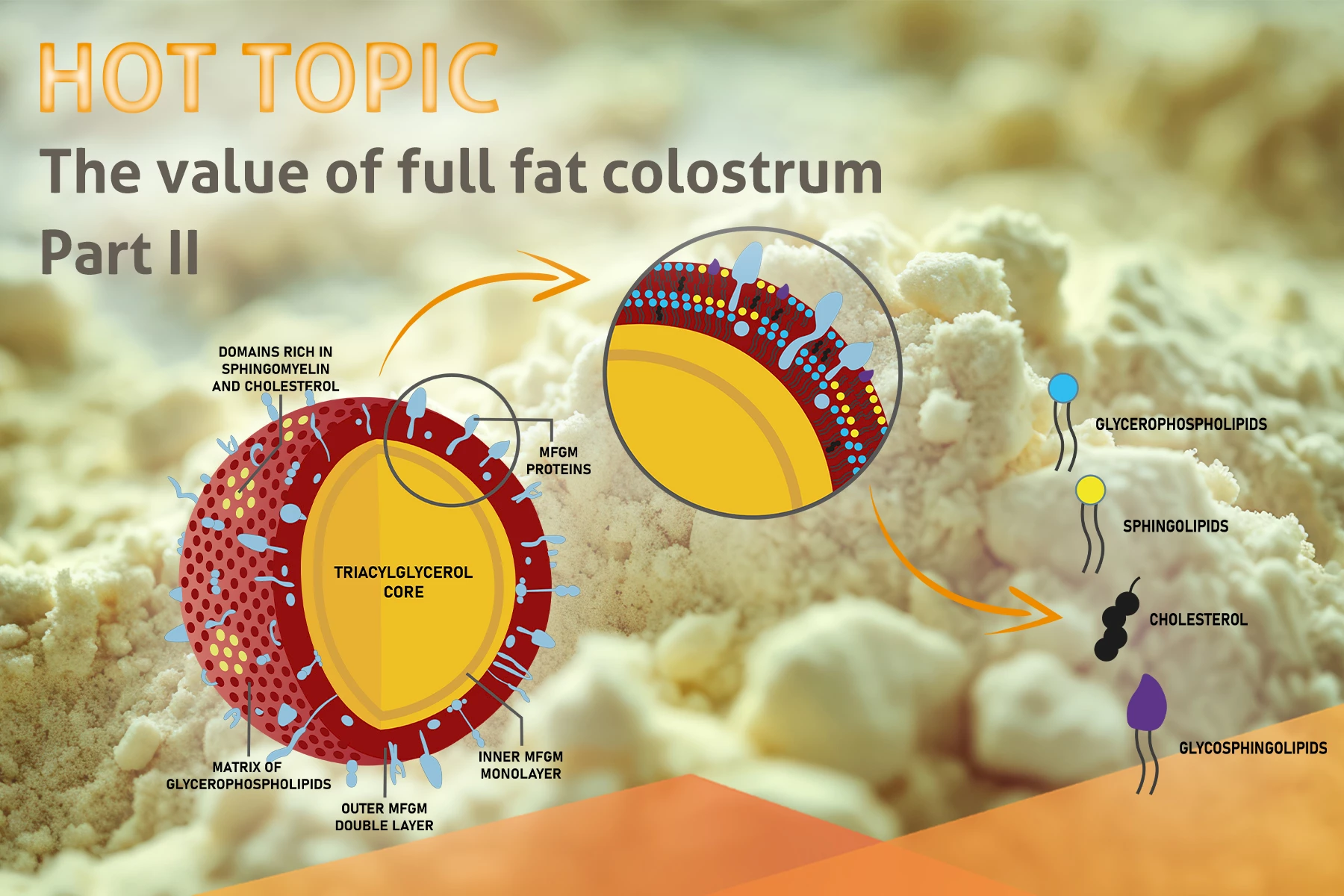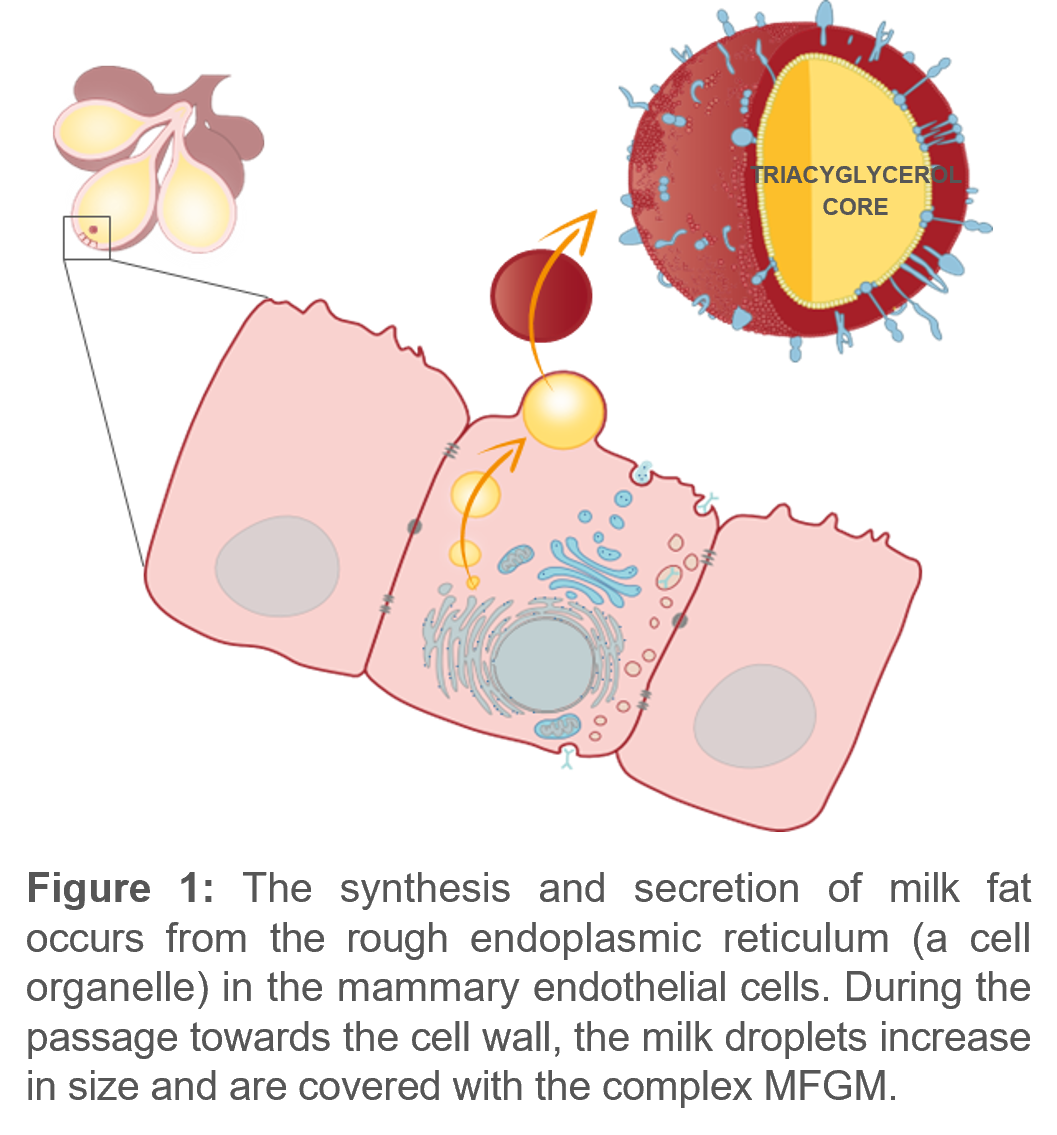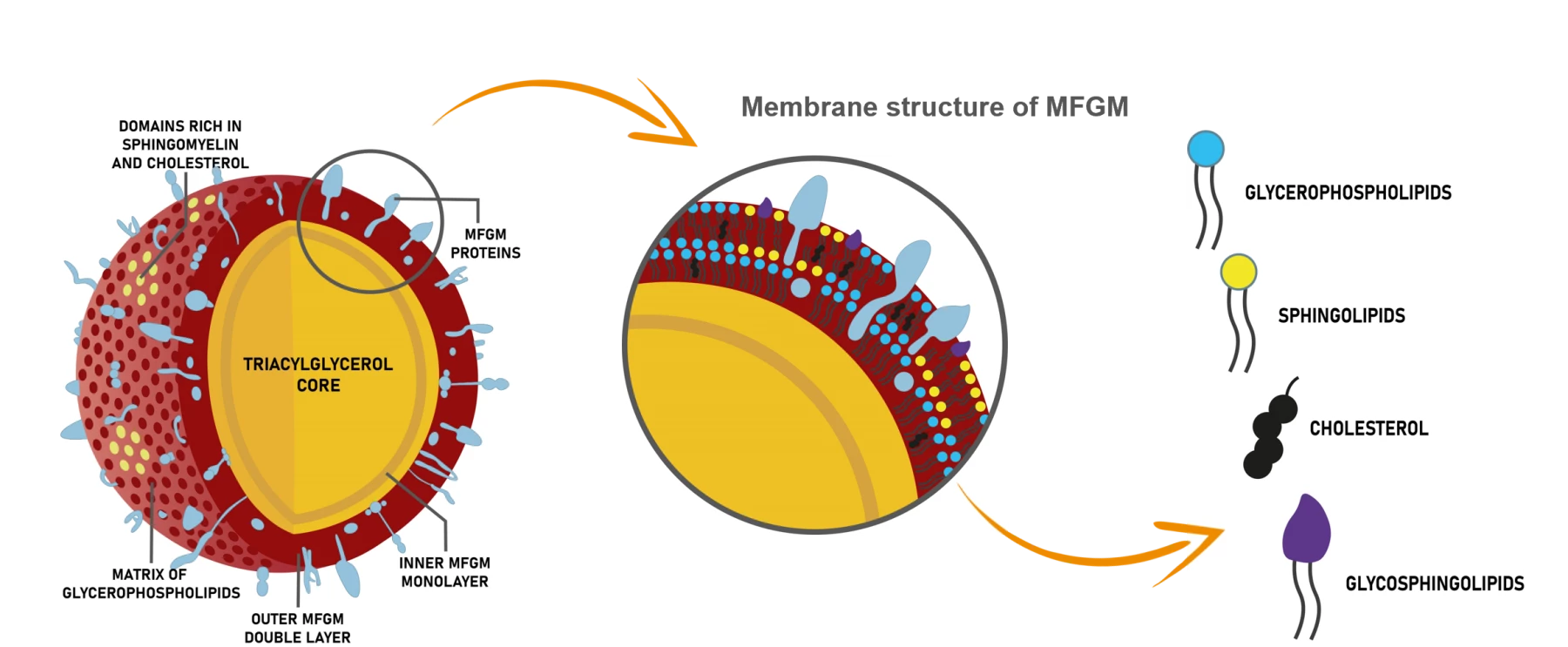
The value of full-fat colostrum, Part II –the special “packaging” form of colostral fat
The previous Hot Topic issue covered the essential role of the colostral fat fraction due to its unique lipid composition. This issue will focus on the structure of the fat globules, which also contributes to the physiological effects of colostrum.
Milk fat globule membrane
Colostrum and Milk fat form droplets with diameter variable in a range of 1–8 µm. Colostrum fat droplets generally have a greater size than milk fat globules. These milk fat globules (MFG, Figure 1) are covered by the so-called milk fat globule membrane (MFGM, Figure 2). The MFGM has three layers, the outermost of which (1) consists of a phospholipid bilayer, interspersed with attached transmembrane proteins and cholesterol. In the center (2) lies a dense second layer, composed mostly of proteins and (3) adjacent to the globule’s triglyceride core is a monolayer of polar lipids. The membrane is 10 to 50 nm thick. Its unique composition acts as a natural emulsion-stabilizing agent preventing flocculation and coalescence and protecting fat globules against enzymatic degradation and oxidation.
Biological activity of the MFG & MFGM
Besides its protective and emulsifying function, the MFGM contributes to the colostral and milk fat biological functions due to the protein fraction and the functional lipids contained in the membrane and the core of the MFG.

The number of different proteins contained in the fat globules varies between 20 and 411, as the protein composition of the globules depends on many factors, including age, breed, parity and nutrition of the animal, as well as the size of the fat globule. The current scientific findings show that the milk fat membrane-associated proteins exert functions related to cell signaling and metabolism, intestinal epithelial homeostasis and immune responses, among others. Among the main functional proteins are lysozymes, lactoferrin, cathelicidins and immunoglobulins. As a change in MFG size is related to a difference in the proteins contained within the MFG, it is hypothesized that the change in protein composition reflects changing needs of the lactating cow and her offspring. For example, as lactation continues, the proteins related to immune and antimicrobial functions have been shown to decrease.
The largest part (around 98 %, depending on the size of the globule) of the MFG’s lipid fraction consists of triacylglycerol core. Some examples of polar lipids contained in the MFGM are phospholipids such as sphingomyelin, phosphatidylcholine, phosphatidylethanolamine and phosphatidylinositol, and glycosphingolipids, comprising cerebrosides and gangliosides. Many of the biological functions of milk and colostral fat, such as involvement in cognitive development and intestinal maturation are attributed to the membrane phospholipids. As shown in the previous Hot Topic, the profile of the individual fatty acids on the fat fraction changes as lactation progresses. Partly, this also applies to the lipids contained in the MFGM, which, similarly to proteins and fatty acids. This change is associated with changing requirements of the young animal.
Colostral fat is a valuable component – do not discard, but handle with care!

Figure 2: Distribution of the phospholipids and selected bioactive proteins that constitute the MFGM
To summarize the previous section, milk lipids significantly contribute to the structural and immunological maturation of the intestinal tract. Epithelial cell proliferation, the expression of tight junction proteins and the establishment of the intestinal microbiota are accelerated when new-born animals consume MFGM. These benefits are lost when defatted colostrum replacers are used. Due to the inter-linkage of proteins and the fat portion, most defatting processes also cause the partial loss of highly valuable functional proteins.
Vulnerability of the MFG structure and possible impacts of processing techniques
The biological effects of the MFGM are partly linked to its structural integrity. As mentioned above, the composition of the MFGM stabilizes the globule and prevents flocculation. Therefore, processing techniques which can disrupt the structure of the MFGM might alter the physiological effects of the fat fraction. For instance, heating colostrum above 60 °C leads to phase separation of the lipids and a different distribution of the outer layer of the MFGM. Although the effect on the digestion and functionality are not yet fully clear, most drying processes using high temperatures could alter the MFGM of the colostral fat fraction. Furthermore, the process of spray-drying has been shown to cause the degradation of the MFGM phospholipids.
In this context, vacuum drying represents the most gentle way to dry raw colostrum. The temperature during the process is kept below 7 °C and no mechanical stress is applied.

In this HOT TOPIC, Phytobiotics expert Dr. Oguz Calisici focusses on the structure of the fat globules, which also contributes to the physiological effects of colostrum.
Download the HOT TOPIC (PDF) >>

Dr. Oguz Calisici studied veterinary medicine in Germany and Turkey. After completing his doctoral Thesis at the University of Hannover, he continued working at the university in the areas of biotechnology and artificial insemination. After working as a practical vet in Germany, Oguz was the managing director of a large dairy company in Turkey. At Phytobiotics, Oguz has taken over the product management of Immune Milk.
Contact our experts or send us a message. We will contact you as soon as possible.